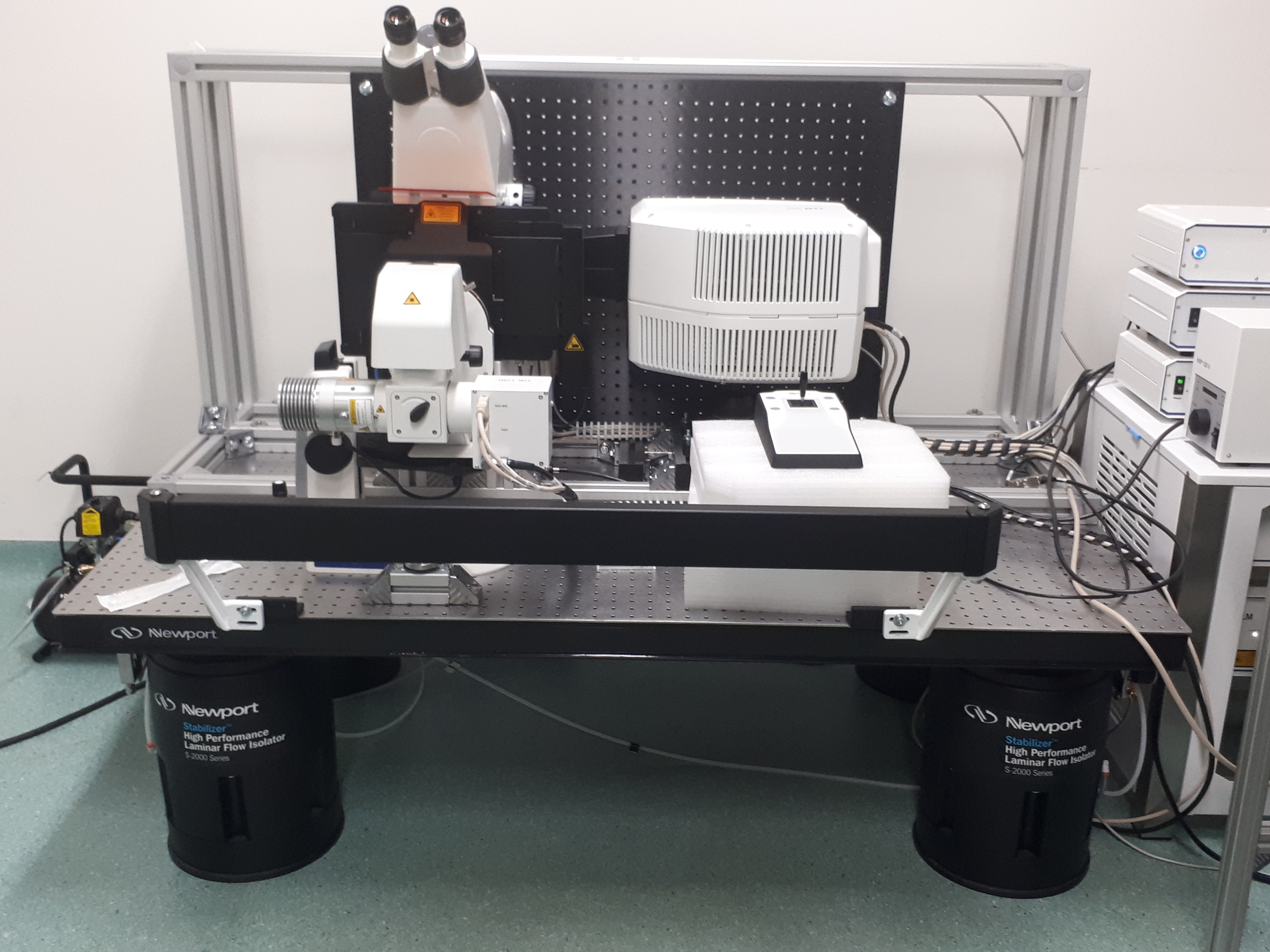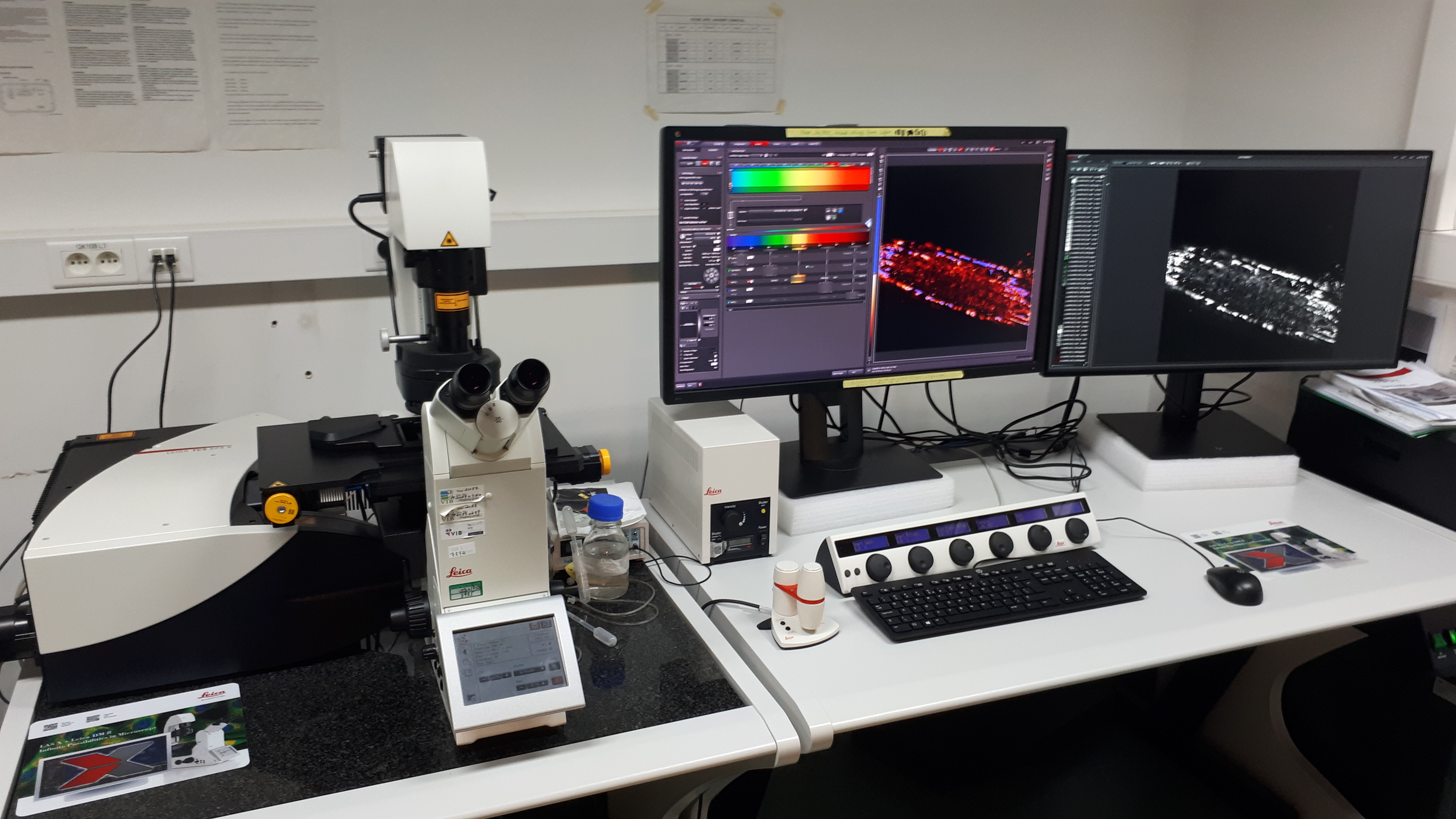PSB Confocals
The PSB features 5 confocal microscopes, ranging from standard devices to more advanced ones. Depending on your experiment, one device will suit your need more than another. Below are some guidelines for choosing the most suitable confocal.
A main criteria is speed.
Whenever speed is crucial than the spinning disc is the best choice. Speed can be in time: imaging of fast events (below 1 sec), in space: large regions to be obtained by stitching and Z-stack, or a combination with multiple colours and Z-stack.
If speed is not crucial, than the other point scanners (Olympus FV1000, Zeiss 710, Leica SP8, Zeiss LSM 900) offers more flexibility. Every system has specific features:
The Leica Stellaris 5 LiAchroic is the newest and most sensitive confocal available at PSB. Equipped with four powerful lasers and three highly sensitive HyD detectors, it offers exceptional imaging capabilities. As the only upright system in PSB, it provides unique opportunities for specific applications, such as shoot apical meristem imaging, especially with future use of water-dipping lenses (not yet available). The Stellaris 5 also features a more powerful 561 nm laser compared to the SP8, making it particularly well-suited for exciting red fluorophores. While the system excels in sensitivity, it does have some limitations. Long lifetime imaging may prove challenging (as upright system), and unlike the Leica SP8, the Stellaris 5 does not feature the ability to gate out light based on fluorescence lifetime.
Leica SP8 is the most sensitive confocal in house and also allows selection of emission light on base of lifetime using LightGate, ideal for eliminating autofluorescence and reflection. With one of the Hyd detectors (SMD Hyd) lifetime differences can be very easily and quickly visualized (FALCON, Fast Lifetime CONtrast). On the other hand it has a much weaker laser for exciting the red fluorophores.
The Zeiss 900 confocal is the only confocal with a vertical setup, allowing to image a root while growing along the gravity vector. This vertical setup combined with a root tracking software (TipTracker and Zen Tracking) makes the system very interesting for tracking a root over a long period of time. Keep in mind that this is mainly done with dry lenses (20x), and that the use of immersion objectives is not userfriendly in this setup.
The Zeiss 710 confocal is a very good 'allround' confocal. It has the advange over the Olympus confocal to be a bit more sensitive and it has a 25, 40 and 60x water lens. This confocal does has a much stronger laser for exciting the red fluorophores, in contrast to the Leica SP8 confocal. Tiptracker, a software tool to be able to track your root over time, is also installed.
The Olympus FV1000 allows imaging different positions in time with different acquisition parameters on a very easy way. Also fluorescent lifetime imaging (FLIM) can be done with this system. However, this confocal has only one water immersion correction lens: 63x whereas the other systems also have a 20 and 40 x water lens.
Confocal trainings for PSB members are organized by Evelien Mylle ([email protected]). Training dates are consultable on the PSB intranet page. Additional information (manual/status issues) can be found on the PSB intranet-information page.
POINT LASER SCANNERS
LSM900 inverted

| Name | LSM900 |
| Application | High resolution confocal imaging, long timelapses where the plant root can be tracked during its growth along the gravity vector, microfluidic experiments |
| Type | vertical tilted inverted confocal |
| Light source | Diode lasers: 405, 488,561, 640 |
| Objectives | EC Plan-Neofluar 10x/NA 0.30 M27 AIR Plan-Apochromat 20x/NA 0.8 M27 AIR MCO ¨ma,-Neofluar 25x/NA0.8 Imm Korr DIC M27 GLYCERINE LD LCI Plan-Apochromat 40x/NA 1.2 Imm Korr DIC M27 GLYCERINE C-Apochromat 63x/NA 1.20 W Korr UV VIS WATER |
| Detectors | 3 GaAsP PMT |
| Software | Zen blue |
| Spectral seperation | 1 spectral based detectors, 2 filter/spectral based detectors. All detectors are linked to each other for their spectral bandwidth |
| Fast Z system (allowing fast Z-stack) | - |
| Stable Z system (reducing drift) | Definite focus.2 |
| Stitching | Yes (tile regions) |
| Extra |
|
FV1000 Olympus
| Name | Olympus FV1000 |
| Application | High resolution confocal imaging, multi-positions live cell imaging, FLIM |
| Type | inverted confocal |
| Light source | Diode lasers: 405, 488, 561, 633 (*) |
| Objectives | UPLSAPO 10x/NA 0.75 AIR UPLSAPO 20x/NA 0.75 AIR UPLFLN 40x O/NA 1.30 OIL UPLSAPO 60x W/NA 1.20 WATER LUCPLFLN 40x /NA 0.60 AIR |
| Detectors | 3 PMT |
| Software | FV1000 |
| Spectral seperation | 2 spectral based detectors, 1 filter based detector |
| Fast Z system (allowing fast Z-stack) | - |
| Stable Z system (reducing drift) | - |
| Stitching | Yes |
| Extra |
|
SP8 Leica

| Name | Leica SP8 |
| Application | High resolution confocal imaging, fast and sensitive confocal imaging, live cell imaging, FLIM, user-friendly XZY imaging |
| Type | inverted confocal |
| Light source | Diode lasers: 405 White light laser (1.5 mWatt): 200 laser lines in the range from 470-670 nm, up to eight laser lines can be used simultaneously |
| Objectives | HC PL APO CS2 10x/0.40 AIR HC PL APO CS2 20x/0.75 AIR Fluotar VISIR 25x/0.95 WATER HC PL APO CS2 40x/1.10 WATER HC PL APO CS2 63x/1.20 WATER |
| Detectors | 2 PMT , 2 Hyd, 1 Hyd SMD2 |
| Software | LASX |
| Spectral seperation | 5 spectral based detectors |
| Fast Z system (allowing fast Z-stack) | Galvano stage (500 um) |
| Stable Z system (reducing drift) | AFC |
| Stitching | Navigator |
| Extra |
|
LSM 710 Zeiss
| Name | Zeiss LSM710 |
| Application | High resolution confocal imaging, live cell imaging |
| Type | inverted confocal |
| Light source | Diode lasers: 405, 559, (633nm*) Argon laser: 458/488/515 |
| Objectives | EC Plan Neofluar 10x/NA 0.30 M27 AIR Plan-Apochromat 20x/NA 0.8 M27 AIR LD LCI Plan-Apochromat 25x/NA 0.8 Imm Korr DIC M27 WATER LD Plan-Neofluar 40x/NA 0.6 Korr M27 AIR C-Apochromat 40x/NA 1.20 W Korr M27 WATER C-Apochromat 63x/NA 1.20 W Korr M27 WATER |
| Detectors | 3 PMT |
| Software | Zen black |
| Spectral seperation | 3 spectral based detectors |
| Fast Z system (allowing fast Z-stack) | - |
| Stable Z system (reducing drift) | - |
| Stitching | yes |
| Extra | An extra slit in front of the UV emission can be inserted in the microscope allowing fast photoconversion of photoswitchable fluorophores on a small spot or a line. |
Stellaris 5 LiAchroic Leica

| Name | Leica Stellaris 5 LiAchroic |
| Application | High resolution confocal imaging, very sensitive |
| Type | upright confocal |
| Light source | Diode lasers: 405 (50mW), 488 (20mW), 561 (20mW), 638 nm (30mW) |
| Objectives | HC PL APO 10x/0.40 CS2 AIR Waterdipping lens (not yet available) |
| Detectors | 3 Hyd S |
| Software | LAS X |
| Spectral seperation | 3 spectral based detectors |
| Fast Z system (allowing fast Z-stack) | Galvano stage (1500 um) |
| Stable Z system (reducing drift) | - |
| Stitching | Navigator |
| Extra | -FRAP & FRET Wizard -Lightning (adaptive deconvolution) |
SPINNING DISC LASER SCANNERS
Spinning disc Ultraview Perkin Elmer
| Name | Nikon Spinning disc - Perkin Elmer - Yokogawa |
| Application |
|
| Type | inverted confocal |
| Light source | Diode lasers: 405, 440, 488, 515nm, 561nm, 640 |
| Objectives | 10x AIR 20x AIR 60x /NA 1.2 WATER 100x/NA 1.45 OIL |
| Detectors | Two Hamamatsu 512x512 EMCCD cameras and a 509 and 580 dichroic kit allow simultaneous imaging of GFP/RFP or CFP/YFP |
| Software | Volocity |
| Spectral seperation | Filter based |
| Fast Z system (allowing fast Z-stack) | Piezo stage (400 um range) |
| Stable Z system (reducing drift) | Perfect Focus System (PFSIII) |
| Stitching | Yes |
| Extra | FRAP module, Ratiometric module |